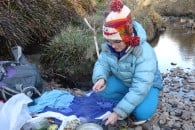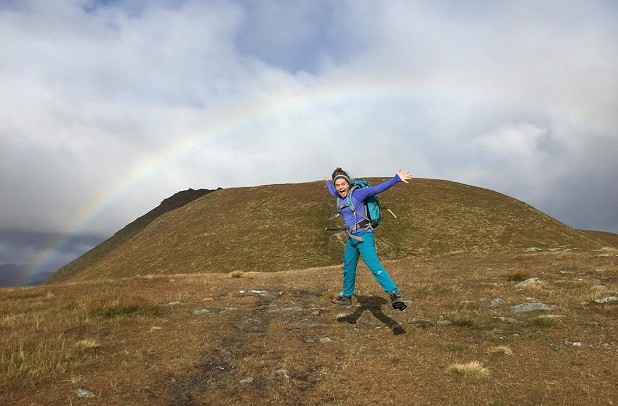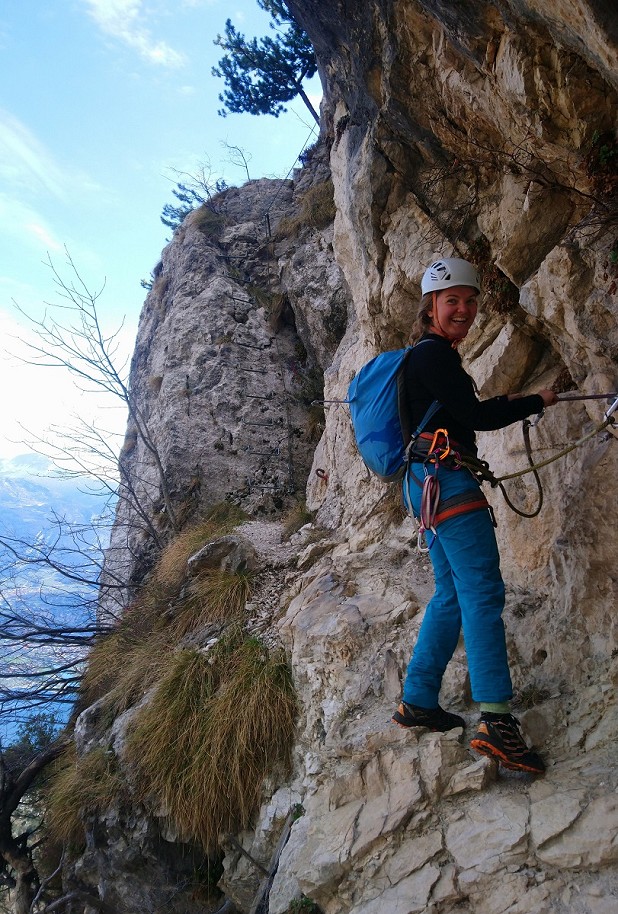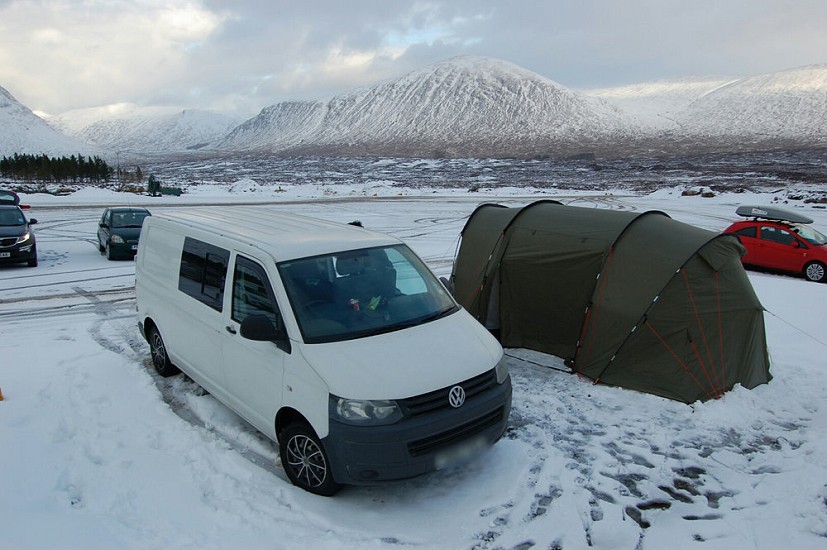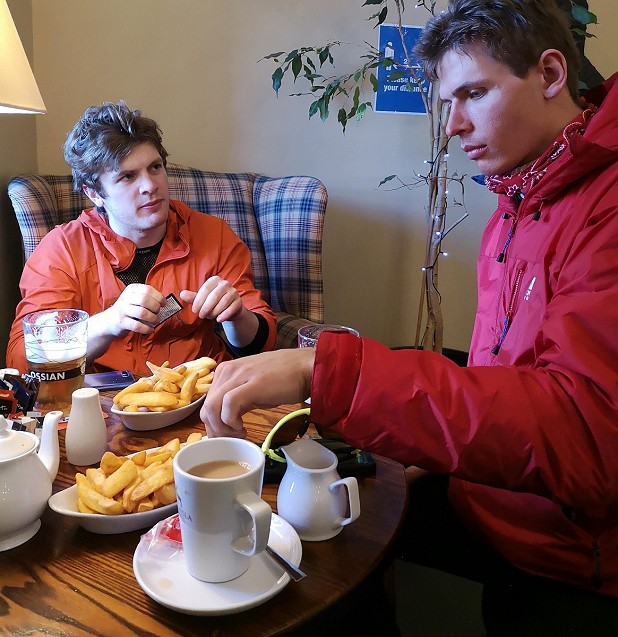Channel Your Inner Dirtbag: How to Save Money in the Outdoors
The outdoors may be free, but all the incidentals soon mount up. Where best to trim a bit of that spend? Professional skinflint Fliss Freeborn offers some well-tested cost-cutting tips, from rocking the second hand gear to dossing in the car park.
You've heard of the dirtbag climber. That's the chap (yes, it's usually a chap) with the van, and the beard, and the slightly weird habit of asking if he can eat your leftovers during breaks from his obscenely difficult project. The dirtbag hillwalker, however, isn't really a thing. You won't catch a munroist asking for crusts at the cairn or hanging about in the Fisherfields in a tent, waiting for a good weather window. These sorts of things don't really happen to hillwalkers or other outdoor enthusiasts, because they tend to a) have jobs and b) enjoy showers.
But I think there's something that all outdoor enthusiasts can learn from the Dirtbag Climber's commitment to running life as cheaply as possible, especially in this ruinous economy. While walking and climbing are in themselves obviously free activities, gear, transport, accommodation and food all add up pretty quickly, and a weekend out can end up costing a lot more than you might think. As a skint-ish person just out of studenthood myself, these are my tried-and-tested tips for saving money in the outdoors.
Kit and clothing
You can spend a fortune on brand new stuff, but how much of it do you really need?
Make do and mend
The best tip for saving money is not to spend it in the first place. So if you can mend it, or make do with existing old tatty gear, then that should be your first port of call. Our societal threshold for replacing kit is so embarrassingly low that we're fine to just throw away a T shirt if it's got a hole in it, rather than sew it up. The benefit of repairing is environmental as well as financial.
And yes, of course there's a point where stuff is falling apart, and can't go on much longer - and when it comes to safety-critical equipment, erring on the side of caution and replacing doubtful stuff is essential. But do you really need a new pair of walking trousers because there's a crampon hole, or the pocket has ripped a bit? See what you can do with a Youtube tutorial and a spare hour or two on a rainy weekend. You might be able to get another few months, or even years out of your kit in return for a little bit of TLC.
Something as basic as regularly washing and (slighly less regularly) reproofing your waterproof jacket and trousers will go a long way to prolonging their serviceable lifespan, making the investment in some suitable product a money saving no-brainer. Here's how:
When it comes to bigger stuff like your tent or rucksack needing repairs, you can send it off to a bunch of professionals rather than doing a bodge-job yourself. Here are some suggestions:
Beg and borrow, but probably don't steal
If you're planning on doing something fun or adventurous which requires specific gear, definitely consider borrowing someone's stuff before splashing out on your own. My most recent example of this was a via ferrata setup - it's not something I do often so I borrowed a mate's for three weeks for a trip. Other kit which I've borrowed for a day or two includes bivvy bags, surfboards, mountain bikes, wellies, kayaks, rucksacks and dogs. If you return the item in good condition, along with a bag of home-baked goodies, you might even be allowed to borrow it again. Of course, this should work both ways - I've lent out my harness, helmet, tent, roll-mat, sleeping bag and poles to various people on different occasions, on the same condition that it comes back to me in the state in which I lent it. I've not had a bad experience with either lending or borrowing yet, so I'm thus far a big advocate for the eco-friendly sharing economy.
Borrowing is also a great way of seeing whether you should invest in the kit long term. The first time I borrowed a down sleeping bag (used with my own liner, of course), I bought one for myself as soon as that trip was over - I'd only used synthetic before so down was mind-blowing. And of course, I saved money on the sleeping bag because I found it on a web-based community.
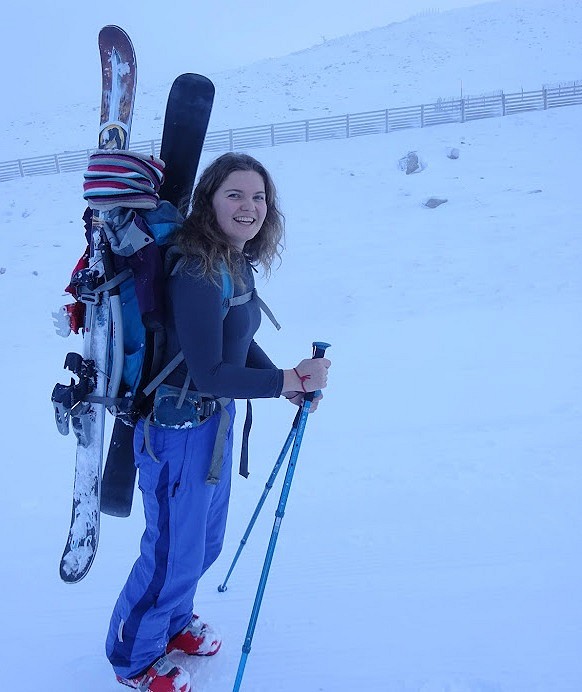
- If a friend can't lend you an item you need for a trip, it could be worth looking into the possibility of hiring something. One such scheme is Rab Rental.
Shop second hand first of all
New outdoor kit is ludicrously expensive. To that end, the vast majority of my outdoor clothing and equipment is second hand, bought primarily online. Whether you're after a camping pan or a camper van, it's worth tapping into online communities of like minded folk, such as the For Sale/Wanted Forum on UKHillwalking & UKClimbing, or Outdoor Gear Exchange, a Facebook page devoted to buying and selling. You can pick up some real bargains this way: my tent, sleeping bag, roll mat, trail shoes, rucksack, skis, and most of my wicking layers and merino were bought this way. Scams and bad experiences are relatively uncommon in comparison to other buying and selling platforms, especially if you pay through PayPal.
Second is Facebook Marketplace, where there are some real hidden gems, often barely used or still with the labels on for a fraction of the cost of a new item. If you find an item that's perfect but miles away, I've found that most people are happy to post if you cover costs. But do be aware of the possibility of encountering stolen goods, so if a seemingly brand new item looks too good to be true, treat it with circumspection.
Ebay is also a great option - I've bought both my stoves and a couple of synthetic jackets from here, plus a little tent which I used for beach trips in the summer.
Back in the real bricks-and-mortar world, charity shops often have some good quality outdoor clothing donated; I've found waterproof trousers, decent water bottles and good sunglasses, plus there's usually a selection of cheap walking boots if you're after something to plug a gap for a weekend or two.
Look out for sales
If you can't bear to buy much second hand (and I'll admit, I'm definitely on the 'don't care at all' end of the spectrum whereas many people seem a little more precious) then you should at least do a bit of bargain hunting before going straight for the full price option. Assuming you're fine with last season's colours, or end of line stuff, there's often a deal to be had online; and if you prefer to support physical shops where possible then head for the sale rail.
But don't let your bargain brain trick you into scrimping on safety
The money-saving urge should of course be mixed with a healthy measure of caution when it comes to safety-critical gear such as ropes, harnesses and climbing hardwear. What price do you put on your life, after all? I know mine hovers just above the price of a new harness.
Do you know the provenance of that second-hand harness? If you can't be sure it's been stored and used correctly by previous owners, then don't do it.
Buying used safety gear is usually a bit of a no-no, but brand new equipment bought online on some of the biggest platforms may also be far from ideal. We've all had those Wish.com adverts for 'climbing ropes' and while you may be smart enough to tell the difference, the less experienced may not. The same goes for buying things on Amazon. The old saying applies here: if it looks too good to be true, then it probably is.
Transport
At the time of writing, fuel is unbearably expensive in the UK, but still not as expensive as getting the sodding train. Although public transport options are infinitely more sustainable and better for the planet than driving in a private car, they're a faff unto themselves, and practically non-existent in further-flung places. This is a crying shame, and I could rant about the injustice of it all for days, but that's for another article.
For now, the most practical mode of transport to the majority of hills and crags is still the car, so here are some tips for saving fuel on your trip:
Take all your mates
I'm not a mathematician on anyone's count, but I do know that a tank of fuel costs less per head when split between four than between just one or two, and will still work out cheaper despite the extra fuel needed to transport the weight of two more humans. So when you're off for a weekend, round up your nearby pals and take them with you rather than going alone. They don't even have to come with you on your excursions, and might prefer instead to visit the local wool museum followed by a scone at that nice cafe by the river. You'll still save on petrol either way. If you're driving a long way and you don't have any friends available, put your journey on Bla-Bla Car to make some of the fuel back by giving some randoms a lift.
Drive at 50mph in the inside lane
Look, most people either have money or time, but not the two at once. If you're like me, you'll have lots of time but little money, so why not save some fuel and get to your destination just a little bit slower? I'm only half joking here too - it really does do wonders for your fuel economy to slow down a bit.
Stay in one place for the weekend
If you're away for a lengthier period of time, such as a long weekend or a week, try not to use the car so much in between. Those shorter journeys do add up. If you're somewhere busy and relatively touristy for your outdoor adventure, you might find that public transport from near your accommodation is cheaper and possibly less hassle than using the car and paying to park at the bottom of the hill or close to the crag (think Borrowdale for instance!). And if that doesn't work you could always try to…
…hitch-hike
I'm writing this from the middle of Slovenia, and I got there partially by hitching. Covid put a stop to almost everything for the last two years, including hitch-hiking but it's slowly becoming easier again to get picked up. This is especially true in the Scottish Highlands where even post-lockdown, I've never had to wait longer than 10 minutes for a lift. It's also a great way to meet people and have some fun and interesting conversations. Safety disclaimers apply.
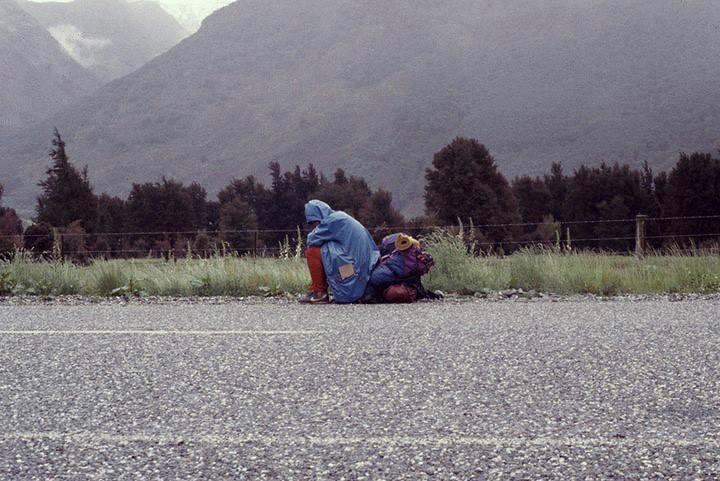
Where to stay?
The whereabouts of the pillow on which you'll be dribbling overnight will have a stark impact on the state of your bank account. Legend has it that cheap B&Bs once existed, but there's nowhere under £50 a night these days, so that's obviously out of the question. Even typical youth hostel rates are pushing it a bit to still be called 'budget' but they do have a time and place, usually when you've just spent a week festering in a wet tent.
Here are some budget accommodation ideas, roughly in order of cheapest to most expensivest:
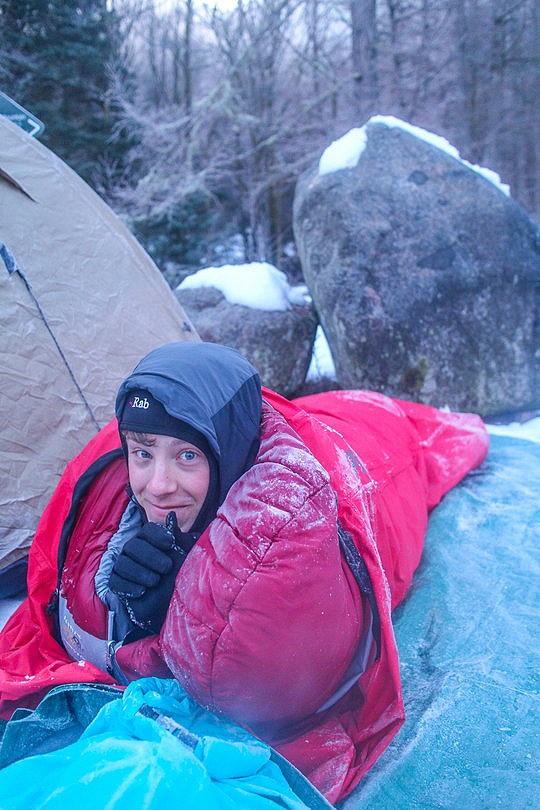
Bothies or wild camping in the hills
Turn your weekend away into a backpacking journey, and accommodation for the night is free. You'll just have a lot to carry. The world is your bedroom with a tent strapped to your back, but bothies are always my aim if there's one nearby. I recently stayed in an unlocked winter room in an alpine hut for five nights, which cut our trip costs tremendously, and kept us warm, dry, and safe from lugging a wet tent about too. All for free, of course.
Car camping 'wild'
The usual option best option for the frugal weekend warrior, and the default for generations of skint hillgoers and climbers, is an informal roadside doss. While it's permitted (if done responsibly) under Scotland's access laws, in the rest of the UK you'll be on dodgier legal ground with this one. But wherever you are, an under-the-radar, zero impact approach is the idea. More advice here:
Van-life
If you can afford to fill the tank (currently a very unpleasant affair) a van gives you transport and accommodation in one, which is pretty great. Everyone's having a go at #Vanlife of course, including me, which means the obvious spots are getting hammered, and locals in these areas increasingly irate. More so even than car camping, a low-impact and considerate approach is needed. Do go and spend some money in the pub or cafes where you can, watch where you poo, and don't park anywhere stupid.
Campsites
What, you like flushing toilets? You great big softie, you. Yeah, alright, official campsites give you a legitimate base to pitch and leave your tent all weekend without worrying that you're annoying anyone, or that your stuff will be ransacked by badgers. They're no longer as cheap as they were, partially due to the ever rising tide of glamping sites (£100? A night? For a glorified tent? What do you mean "Instagram?" You chancers!), but they're still ok when you compare them with the price of a hostel. And cheap and cheerful sites (under £10/pp a night) do still exist even in popular places like the Lakes. If we want basic affordable campsites to continue to exist for future generations then there's a good argument for occasionally splashing out on them. And who doesn't appreciate a nice hot shower every now and again?
Club huts
Perhaps you're a member of a mountaineering club, or know someone who is? Club membership allows you to tap into a network of huts run by other clubs in climbing and hillwalking hotspots across the country. Facilities may be basic, and you'll need to book in advance, but it's a great way to secure a roof for the night at a cost that won't make your eyeballs fall out of their sockets (even when factoring in club membership subs).
Hostels
Luxury. When we were young, we'd wake up dead in a puddle, and then walk 33 miles to the next bog and we were lucky.
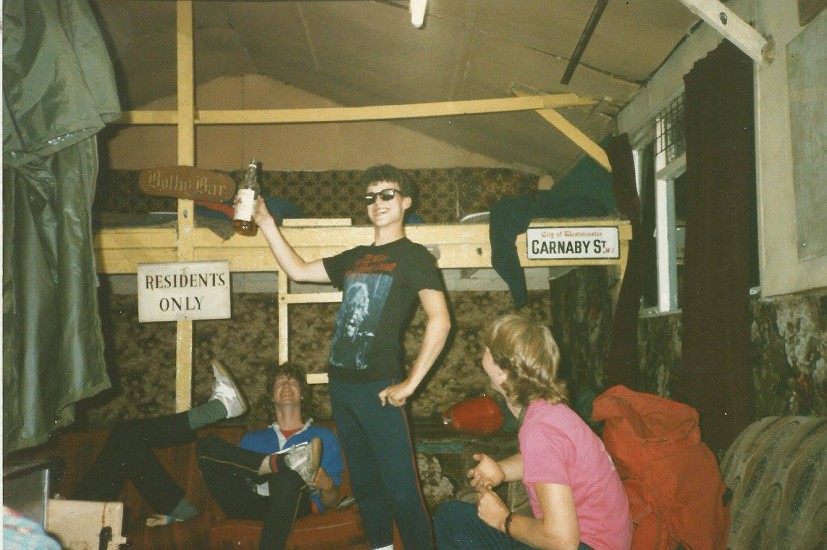
Food
Over a weekend, food is probably the least costly entity in comparison to transport, accomodation and kit. The only place where this isn't true is if you're doing daft things such as going for multiple pints and pub meals every evening - and if you are, then you probably don't need to worry about saving money in the first place. But rejoice, because I am not Pub Grinch by any means. Here are my top tips for doing food cheaply but properly on a weekend away.
How to save money while still managing to fester in the pub
To make your pint go further, consider not eating enough all day and being extremely dehydrated by the time you sit down in the sunny beer garden. To that end, always order a pint of tap water along with your drink - as well as being properly hydrating, it enables you to sit for at least double the time before you start getting side-eye from the bar-staff for not spending any more cash. Snack-wise (I'm assuming that £12 burgers aren't exactly in the budget here), let it be known that when it comes to cash-for-calories, chips are usually much better value than crisps, despite an initial higher spend. And make sure you see someone else order the cake first so you can gauge the portion size to see if it's worth the £3.20 they're asking for it.
Not having a decent dinner is a false economy
The cheapest option for dinner is to bring instant noodles and chocolate biscuits, but you're not going to be getting much bang for your buck nutrition-wise, despite the seemingly high calorie count. Due to a massive insulin spike, you'll wake up hungry, and probably have to put in way more extra fuel the next day. And while a cold dinner such as a sandwich, wrap or pasta salad is ok for a night, by the evening of day two you'll be hankering after something hot and filling. Luckily, to get you started I've written recipes for five nutritious, delicious camping meals, most of which are light on the gas and easy on the wallet:
Avoid expensive protein bars, gels or sports drinks
If you're not power-lifting or cycling 300km a day, you really, really don't need isotonic sports drinks or gels. And while protein bars can be a handy way of inserting some quick nutrition, most of the time they're expensive and taste bit crap. Instead, take a range of sweet and savoury snacks including items such as oatcakes, cheese, salami and pork pies, which are high in both protein and fat and relatively inexpensive. (As an aside, it has been established via science that cold pizza is the best overall hill-food, and is also wonderfully cheap).
Finally, if you've got the time, try making some of your own hill-bakes; the tea-loaf from this list is the best value option in terms of calories for money, and transports really well:
Pack glove-box snacks
I often find the time when I spend the most money is when I'm ravenous in the shop on the way home, so having something like a bag of dried apricots or some cheesy oatcakes in the glovebox is a good way of keeping me from spending £129 on mini-eggs while filling up with fuel.
So that's it. That's how to spend as little cash as possible when you're outdoors. Naturally, being outdoorsy is inevitably more expensive than sitting with your finger up your nose watching daytime telly, but I think for all the good it does our minds and bodies, it's completely worth it.
